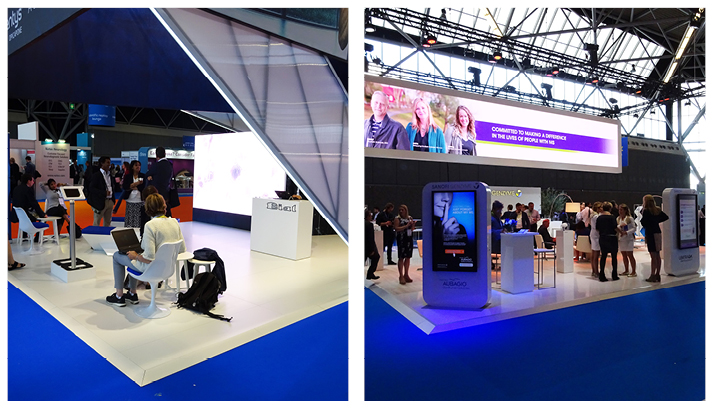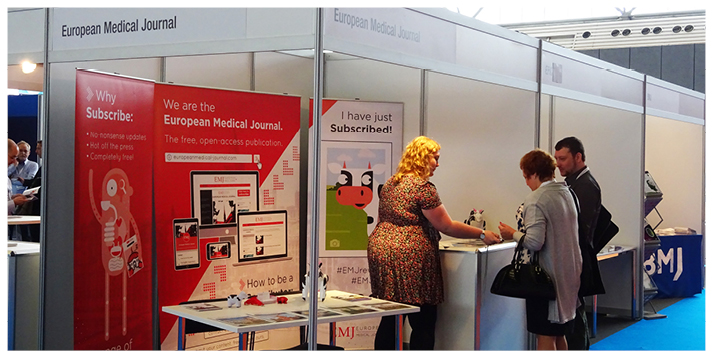The 3rd Annual Congress of the European Academy of Neurology (EAN) was held in the vibrant city of Amsterdam, Netherlands, from 24th–27th June 2017. The RAI Amsterdam Convention Centre, in this captivating, creative capital city, was the perfect location for this meeting and welcomed >6,000 attendees from across the world. Indeed, there were several opportunities arranged to allow congress attendees to experience the delights of the city. The opening day of the congress saw a History of Neuroscience tour organised, which took guests through the original medieval section of Amsterdam and highlighted some intriguing points of historical interest. Those who took part were shown snapshots of Amsterdam’s medical past, such as the location of the cloisters, where the city’s very first autopsies took place and the hospital building where Wertheim Salomonson and Winkler initiated early Dutch neurology. Furthermore, a stop was made at the site where Rembrandt painted his famous masterpiece Anatomic Lessons by Tulp and Deyman. This tour was an excellent opportunity for visitors to the city to get a sense of its medical past and draw inspiration from it.
Although aimed at clinicians, researchers, industry professionals, and industry experts, this year’s event also piqued the interest of those outside of the field of neurology and was graced with the presence of HM. Queen Máxima of the Netherlands, who personally attended lectures and met with leading EAN representatives. EAN President Prof Günther Deuschl commented: “The EAN is very honoured by Queen Máxima’s visit and is delighted with the interest she showed in the topics we are discussing at the congress. In fact, there is hardly another discipline that is developing as rapidly as neurology. And this fast pace is urgently required given the growing disease burden.” Acting as a forum for clinical and scientific discussion on a range of neurological topics, EAN 2017 covered a range of learning objectives in the form of plenary symposia, focussed and case-based workshops, hands-on sessions, teaching courses, interactive sessions, and career development workshops. There were also many other networking sessions targeted for attendees, such as the ‘Challenges for Women in Neurology’ session. This was designed for female neurology residents and female neurologists who were in the early days of their career and was intended to enable determination of the potential challenges facing women during an academic and hospital career in neurology, in order to help them surmount these obstacles.
A vast variety of subjects were covered throughout the 4 days, highlighting distinct subtopics within the field including the pathophysiology of neurological diseases, diagnostic and therapeutic approaches, and available pharmacological and non-pharmacological treatment options. These perfectly complimented the overarching congress theme of ‘outcome measures in neurology’.
In his opening address, Prof Bernard Uitdehaag, EAN’s Local Chairperson, explained the aim of this year’s opening ceremony: “In this opening session we want to express the exciting and ever-moving aspects of neurology.” He then welcomed Prof Günther Deuschl to the stage to deliver his Presidential speech. Prof Deuschl began by sharing his personal selection of papers, and amongst these, he highlighted the DAWN Study, explaining that mechanical thrombectomy between 6 and 24 hours from symptom onset significantly prevented disability in severe stroke patients displaying ‘mismatch’ on brain imaging. He also emphasised the importance of several other papers; firstly, a trial comparing the effectiveness of ocrelizumab versus placebo in primary progressive multiple sclerosis. Secondly, he discussed studies demonstrating that aducanumab reduces amyloid-β plaques in Alzheimer’s disease. Until now, treatments had predominately been aimed at symptomatic improvement. He commented: “These are all exciting new developments in our field, we should really look into these and be proud that we are now approaching territories that we couldn’t treat before.”
When the opening introductions were complete, EAN honorary member awards were presented to both Marie-Germaine Bousser (France) and Raad Shakir (UK). It was then Prof Bas Bloem’s turn to take to the stage to present the ceremony’s opening lecture: ’Quality Cycles: How to Measure Moving Targets’. Finally, there was a spectacular acrobatic performance, which aimed to depict the vibrant, dynamic, harmonious Dutch culture, reflected across the Netherlands.
This year’s EAN Congress brought together thousands of experts to discuss the latest advancements within the field of neurology. I am sure many of you, with eager anticipation, will already be looking forward to the arrival of EAN 2018, the 4th Congress of the European Academy of Neurology, due to be held in Lisbon, Portugal. We hope you enjoy reading this year’s EAN highlights.

Europe Playing a Leading Role in Neurological Research
NEUROLOGY research in Europe is particularly impressive in terms of both quality and quantity, according to an analysis presented in a EAN press release dated 27th June 2017. This important study also introduced a new potential metric, inspired by gross domestic product, to measure the number of peer-reviewed neurological articles that have been published in the Scopus database, named ‘gross neurological product’.
Prof Giorgio Cruccu, Department of Neurology and Psychiatry, “Sapienza” University of Rome, Rome, Italy, examined the number of neurological articles produced across a range of countries, including the 46 with national neurological societies that are EAN members. The results showed that the number of published studies had doubled from ˜5,300 to 10,600 among the 10 most productive European countries between the years 2000 and 2015. In Germany alone during these years, the gross neurological product increased from ˜1,500 to ˜3,400 publications per year.
“The 10 top-performing European nations together are on a par with the USA,” said Prof Cruccu. “Some countries have made great progress during this period, but the level of scientific productivity in neurology has risen sharply across the entire region.” In addition, it was demonstrated that the quality of neurological publications had substantially improved over the same period, with the number published in the top 20 journals with high impact factors rising by >140%. This study therefore confirmed the central role that Europe plays in the advancement of the field of neurology.
“Europe is a highly productive region when it comes to neurological research, and is improving all the time,” commented EAN President Prof Günther Deuschl, University Medical Center Schlewswig-Holstein, Kiel, Germany. “This has always been the case, so the results hardly come as a surprise. After all, neurological research originated in Europe, and many of the breakthroughs in this particular discipline are made there. The EAN congress remains dedicated to ensuring that things remain that way.”
Focus on Neurological Outcomes Measures
MEASURING outcomes was a core theme of the EAN congress and was consequently discussed at a number of sessions, as reported on in a EAN press release dated 25th June 2017. Both practitioners and patients are key stakeholders in this regard, for a number of reasons. The identification of suitable outcomes measures can allow determination of the efficacy of a treatment, whether it results in the intended improvements, and if it delays the progression of a condition. Furthermore, this allows a consideration of whether the benefit of the treatment makes it worth carrying out, both in terms of financial cost and the burden a treatment may place on a patient (e.g. adverse effects).
Prof Paul Boon, EAN Programme Committee Chairman, stated that he believed the benefits for patients were of the greatest relevance for neurologists when measuring outcomes. He commented: “Of course, the clinical explanation of the disease mechanism revealed through such indicators is very important, but patients obviously focus on other aspects.” For instance, outcomes measurements should enable neurologists to answer questions such as: ‘Will my seizures or headache attacks stop?’ Continuing this theme, outcomes measurements are beginning to become more patient-focussed for some conditions. For example, the number of seizures or headache attacks is a well-established metric for measuring outcomes for epilepsy and migraine. However, Prof Boon explained: “Recently, the measurements have become more differentiated. For example, we record days free of complaints. For patients, this metric is more meaningful than the total number of seizures.”
On the other hand, in today’s often financially constrained world, it is more and more crucial for neurologists to be able to demonstrate the efficacy of a treatment to see if it can be financially justified. As new treatments are also being developed, comparing one treatment against another in terms of outcomes measures is highly pertinent. Therefore, neurologists can expect to see further developments for measuring outcomes in the future.

Cognitive Disorders Affected by Metabolic Syndromes
COGNITIVE ability can be influenced by overweight comorbidities, according to a EAN press release dated 27th June 2017. It has long been thought that individuals with metabolic syndrome are more likely to suffer from impaired cognition, and to a greater extent. Whether obese individuals without risk factors, such as diabetes, have an increased risk of cognitive impairment was investigated by a group of Israeli researchers.
Individuals with a BMI >30 (N=60) were subdivided into two groups, those with one component of metabolic syndrome (n=30), and those with two or more components (n=30). Individual cognitive function was then assessed using the Montreal Cognitive Assessment Score (MOCA).
Results indicated that while cognitive ability is not determined by a high BMI, it is influenced by similar risk factors. Of the 30 individuals with several components of metabolic syndrome, 13% had dementia, 51% had milder forms of cognitive impairment, and 36% had no signs of cognitive dysfunction. This was compared to the 90% of the control group who had normal cognitive function; 7% showed mild impairment, and the remaining 3% were already diagnosed with dementia. “There is a clear association between metabolic risk factors and cognitive impairment,” summarised Dr Radi Shahien and Dr Aleh Abu Salach, Ziv Medical Centre, Safed, Israel. It was ascertained that abnormal girth and age were the two largest risk factors along with a strong correlation with high blood pressure and liver stiffness. Dr Shahien, lead author, commented: “Additional studies need to be undertaken to show whether treatment of individual factors in metabolic syndrome can improve cognitive function.”
A second study, from Karolinska Institute, Stockholm, Sweden, was also presented at EAN which investigated diabetes mellitus in a cohort of dementia patients. A total of 29,630 individuals with cognitive impairments were included, 4,881 of whom also had diabetes. Of the individuals studied, those who were younger when diagnosed with dementia were also more likely to suffer from diabetes. The study also found that those with dementia received less treatment with antidepressants and were also prescribed significantly less Alzheimer’s medication.
Motor Fluctuations in Parkinson’s Controlled Using Apomorphine
APOMORPHINE subcutaneous infusion has been shown to be an effective treatment for Parkinson’s disease patients, according to a EAN press release dated 27th June 2017. The TOLEDO study concluded that apomorphine subcutaneous infusion reduces off-time in Parkinson’s patients, known as the time when medication is not working at its optimum, therefore resulting in exacerbated symptoms. The study’s lead investigator, Adjunct Prof Regina Katzenschlager, Donauspital, Vienna, Austria, commented: “Our results provide high level evidence that apomorphine infusion is an effective treatment method for Parkinson’s patients whose motor fluctuations are inadequately controlled by other therapies.”
Previous studies have demonstrated that treatment with infusions with apomorphine shortens the off-time in Parkinson’s patients, improves dyskinesia, and reduces the need for one of the most commonly orally administered Parkinson’s drugs, levodopa. However, the TOLEDO trial was the first clinical controlled trial to confirm the efficacy of apomorphine infusion for Parkinson’s patients. Patients from 23 centres in seven countries around the world were randomised to receive either apomorphine subcutaneous infusion or a placebo infusion of saline. Infusions continued for 12 weeks. Patients receiving the apomorphine infusion reported considerable reduction in off-time and a substantial prolonged on-time without dyskinesia. Efficacy of infusion was considered better by the apomorphine group than the placebo group. Dr Katzenschlager summarised: “The medication was well tolerated. We detected no unexpected adverse effects. The study results should encourage us to prescribe to our Parkinson’s patients with severe motor fluctuations this effective therapy, which has been all too rarely used thus far.”

Connection Between Hypertension and Parkinson’s Disease is Revealed
SERIOUS forms of Parkinson’s disease are associated with patients who also experience hypertension, according to a EAN press release dated 25th June 2017. Although previous studies have reported that certain medications used to treat high blood pressure also reduced the risk of developing Parkinson’s disease, until now no study has discovered the exact reason for this connection. A new understanding of this relationship may help to reduce the symptoms of Parkinson’s disease simply by managing patient blood pressure.
A British-Italian team, led by Dr Beniamino Giordano, Neurodegenerative Imaging Group, King’s College London, London, UK, has demonstrated the relationship between hypertension and more serious forms of the neurodegenerative disease. By studying data from the Parkinson’s Progression Markers Initiative (PPMI) database, researchers were able to highlight any differences between Parkinson’s patients who did and did not experience hypertension, particularly focussing on the markers of early, untreated Parkinson’s. These markers included motor and non-motor symptoms, neurological parameters, various biomarkers, and dopaminergic status.
Investigation into these Parkinson’s cases revealed that patients also experiencing hypertension showed more severe motor symptoms, including muscular rigidity or reduced speed of motor functions, and a reduction in the function of the associated basal ganglia. Dr Beniamino commented: “Our results show that patients with hypertension have more serious forms of Parkinson’s disease than patients with normal blood pressure.” Although this discovery is at its early stage and further analysis is required to pinpoint more exact reasons for this connection, these findings may help drive the detection of important treatments for Parkinson’s disease. The authors concluded: “The results suggest that optimum management of high blood pressure can also improve Parkinson’s disease symptoms.”
Neurological Disease Cost and International Collaboration Unmet by Current Research
NEUROLOGICAL disease resource needs are not being met, according to a EAN press release dated 24th June 2017. During the 3rd EAN Congress, EAN President Prof Günther Deuschl voiced his worries, saying: “I am concerned about tendencies toward Europe scepticism and a short-sighted restriction to national interests, including research projects.” He went on to further describe the situation: “Like climate change, the global increase in neurological disease is a challenge that no one country can meet alone.” To highlight the gigantic nature of the problem faced due to the lack of European collaboration and funding, >220 million people in Europe suffer from neurological disease, which equates to more than the combined populations of Germany, France, and the UK.
The most common neurological diseases are headaches (152.8 million cases) and sleep disorders (44.9 million). Many neurological diseases such as stroke (8.2 million), dementia (6.3 million), and Parkinson’s disease, are age-related diseases, and with the European Union (EU) population aged >65 years set to double by 2060 to 52%, the cost of neurological diseases is no doubt going to explode over the coming years.
Analysing the direct and indirect costs of neurological disease makes for astounding reading. The combined, direct, and indirect costs of neurological disease amount to ˜€336 billion per year, more than the total German federal government budget. Subdividing neurological disease, dementia is the most costly, totting up to €105 billion, followed by strokes (€64 billion) and headaches (€43 billion). Treatment of neurological diseases and direct non-medical costs account for €122 billion and indirect costs, often overlooked, including sick leave and early retirement, amount to €93 billion.
Prof Deuschl went on to describe the need for European-wide collaboration on neurological research spanning multiple centres and across borders; as shown in cardiology research, multicentre studies have over twice the impact of single-centre studies. With healthcare research accounting for only 4% of the €1.4 trillion spent on healthcare in the 28 EU member states, Prof Deuschl concluded: “I therefore call for an adequate level of research funding that not only allows thinking outside national boxes but actively calls on people to do so.”

New Hope for Chronic Migraine Patients
EXCITING news of a potential new treatment for chronic migraine was presented at this year’s EAN congress, according to a EAN press release dated 26th June 2017. A new, fully human, monoclonal antibody named erenumab has shown promising results in a Phase II trial conducted in Denmark, Germany, and the USA that tested the drug in patients who had chronic migraine and found it reduced the number of days per month that sufferers had migraines on in comparison with a placebo group. The mechanism of the much- anticipated antibody erenumab blocks the calcitonin gene-related peptide receptor, which is thought to play a role in transmitting pain-inducing migraine signals.
In a sub-analysis of the trial, the research team stratified the patient cohort based on their medication overuse (i.e. those who took a stronger dose of medication than recommended in an attempt to remedy their migraines) and then divided the cohort into three groups. Group 1 was given the placebo drug, Group 2 received 70 mg of erenumab, and Group 3 received 140 mg of erenumab.
In Groups 2 and 3 the frequency of migraine attacks was reduced by at least half for >30% of participants (35% and 36%, respectively). In Group 1, this occurred for only 18% of participants. The team also noted that patients in Groups 2 and 3 were able to manage their migraines without additional medication for 5.4 and 4.9 further days of the month, respectively, while Group 1 participants were only able to forego an additional 2.1 days per month without the extra dosage.
“Our analysis shows that erenumab reduces the number of migraine days in patients with medication overuse just as efficiently as in the group as a whole,” Prof Hans-Christoph Diener, Department of Neurology, University of Duisburg-Essen, Duisburg, Germany explained.
Cannabinoids Investigated for Treatment of Migraine
DEBATE around the use of cannabinoids for the treatment of a myriad of medical conditions continues across Europe, amid an influx of trial results looking at the efficacy of these controversial drugs. The results of an investigation in which cannabinoids were tested as a prophylaxis for migraine and as treatment for migraines and cluster headaches were reported on in a EAN press release dated 24th June 2017.
The study, conducted in Italy, first set out to discover the most effective dosage of the cannabinoids for headaches. A starting dose of 10 mg was given orally to 48 chronic migraine patients, in a combination of two compounds; the first contained 19% tetrahydrocannabinol (THC) and the second contained 9% cannabidiol (CBD) content, but no THC. The team found that doses <100 mg were ineffectual and that a 200 mg dose elicited a 55% drop in acute pain.
Phase II of the study saw 79 chronic migraine patients consume either a dose of 25 mg of amitriptyline once per day (a commonly used antidepressant for migraine) or 200 mg of the THC-CBD combination over 3 months. Additionally, a group of 48 cluster headache patients were treated with either 200 mg THC-CBD or a daily 480 mg dose of the calcium channel blocker verapamil. In both groups, an additional 200 mg TCH-CBD was given for acute pain.
A number of insights were gained from the trial following the 3-month treatment and 4-month follow-up. TCH-CBD was slightly more effective than amitriptyline (40.1%), with a 40.4% and 40.1% decrease in attacks, respectively, although the severity and number of cluster headaches did not decrease very much. The researchers noticed that cannabinoids were effective in migraine patients, reducing pain by 43.5% with similar results in cluster headache patients who had suffered from migraines in their childhood; those who had never suffered migraines did not show any improvement.
Dr Maria Nicolodi, Interuniversity Center, Neurochemistry and Clinical Pharmacology of Idiopathic Headache, Florence, Italy, explained: “We were able to demonstrate that cannabinoids are an alternative to established treatments in migraine prevention. That said, they are only suited for use in the acute treatment of cluster headaches in patients with a history of migraine from childhood on.”

Personality a Strong Factor in the Development of Migraine and Depression
PERSONALITY may be a key indicator for susceptibility to migraine and depression. This is according to a joint Hungarian/UK study, described in a EAN press release dated 27th June 2017. The researchers analysed the relationship between personality, depression, and migraine in >3,000 participants in Budapest, Hungary, and Manchester, UK, finding that people with depression are much more likely to experience migraines. “This situation can only be partially explained by genetic risk factors, which is why we analysed personality traits using the Big Five Inventory,” stated Dr Máté Magyar, Semmelweis University, Budapest, Hungary.
In the Big Five Inventory, human personalities are assessed on five higher-order dimensions: openness, conscientiousness, extraversion, agreeableness, and neuroticism. In the study, participants who scored highly for neuroticism, which encompasses irritability, nervousness, persistent dissatisfaction, and frequent experience of negative emotions, were particularly susceptible to depression and migraine. Interestingly, migraine did not always co-occur with depression, and some participants who had never suffered from depression experienced migraines, further emphasising the importance of personality in the onset of these conditions. This particular subset of participants scored highly for openness, which includes traits such as intellectual curiosity and a preference for variation over routine.
“Neuroticism is an independent risk factor for depression and for migraine. An open character appears to offer protection from the co-occurrence of these diseases. Our study results could help to provide a better understanding of the biopsychosocial background of migraine, and help to find novel strategies in the prevention of and interventions for these conditions,” concluded Dr Magyar.
Influence of Sleep Deprivation and Disruption
DEPRIVATION or disruption of sleep can have an impact on both the mind and the body. This topic was discussed at the EAN congress and reported on in a EAN press release dated 24th June 2017. Speaking at the congress, Prof Pierre Maquet, Neurology Department, University of Liège, Liège, Belgium, declared: “Too little sleep reduces our cognitive abilities and has a negative impact on physical health. Unfortunately, this crucial topic is still all too often undervalued in the healthcare sector.” Several health impacts of a lack of sleep were outlined at the congress.
Prof Maquet discussed how sleep influenced the retention of memories in the brain. He explained that, while we may remember information in the short term: “Apparently, the memory traces laid down following every new item of information remain fragile until they are firmed up and incorporated in the long-term memory while a person is asleep.”
As well as impacting cognitive processes, a lack of sleep can also influence physical ones. Prof Romijn, Department of Internal Medicine, Academic Medical Center, Amsterdam, Netherlands, spoke about the results of a study he was one of the authors for. In this study, reduced sleep was found to have a disruptive effect on metabolism, with participants (both controls and patients with Type 1 diabetes mellitus) displaying almost one-quarter less sensitivity to insulin after sleeping for 4 hours, in a single night. Prof Romijn suggested that reduced sleep could influence the activity of the autonomous nervous system and thereby bring about this change, though he emphasised that little was known about potential mechanisms to explain this finding. Based on this, and other findings, Prof Maquet exhorted his neurological colleagues to give due consideration to sleep quality when treating their patients. He announced: “We must increasingly recognise that sleep has a decisive influence on health and the course of many neurological diseases.”

Thrombectomy Can Help More than 6 Hours After Stroke
STROKE treatments have massively advanced over the past few years. A press release from this year’s EAN congress, dated 24th June 2017, indicates vast improvements are on the horizon for stroke patients if current treatment practises are extended past the 6-hour allotted treatment time. Stroke has been termed a 21st century epidemic, affecting approximately one-fifth of women, and one-sixth of men worldwide. Intravenous thrombolysis was developed 15 years ago, greatly improving stroke treatment, and works by dissolving stroke-causing clots in brain vessels using medication. However, 10–20% of occlusions are so large that thrombolysis treatment does not work effectively.
An alternative technique is endovascular thrombectomy, a catheter inserted via the groin, which physically removes blood clots from the brain. Prof Urs Fischer, Secretary General of the European Stroke Organisation (ESO) and Department of Neurology, University of Bern, Bern, Switzerland commented on the radical improvement thrombectomy provides stroke patients, saying that they “show signs of improvement immediately after recanalisation” and, remarkably, many can be discharged after just a few days. The effectiveness of this treatment is well documented; eight studies have conclusively reported endovascular treatment as superior to medicated alternatives.
Whilst thrombectomy practice is increasing, it currently only benefits a small proportion of stroke patients. The untapped potential of this treatment is attributed to a belief that there is a 6-hour time window for surgery to be performed in. However, recently released DAWN study data showed that 48.6% of patients survived, without serious disability, when receiving combined thrombectomy and thrombolysis treatment for a stroke occurring >6 hours prior, compared to only 13.1% of the medicated control group. These results show a “relative reduction in disability of 73.0%,” summarised Prof Fischer. He added: “These new insights may enable us to increase the number of patients able to lead an independent, disability-free life by up to 270%.”
Other limiting factors for achieving the thrombectomy treatment potential include hospitals being unequipped with stroke units or sufficiently trained staff, or too much time passing from the stoke event to the start of treatment. Prof Fischer acknowledged that there is still room for improvement in stroke treatment at individual centres.
Birth Month Influences Risk of Developing Guillain-Barré Syndrome
BABIES born in the month of October have an increased risk of developing Guillain-Barré Syndrome (GBS), according to the results of a Serbian, Bosnian, and Montenegrin study unveiled in a EAN press release issued on the 26th June 2017. GBS is an acute autoimmune disorder that affects the peripheral nervous system; symptoms include tingling and weakness in the lower limbs, and, in some instances, this can spread to the arms and upper body. In severe cases, it can leave patients in a paralysed state and can be life-threatening.1
The study, presented during the 2017 EAN Congress, included the records of ˜450 patients between 2009 and 2015. An analysis indicated that the likelihood of development of GBS varies depending on the specific month in which the infant is born. When compared to the general population, those with birthdays in October had a 27% increase in rate of GBS development. For study participants with a recorded birth date in June, there was a 28% lower likelihood of GBS. When conducting data analysis by season, it was revealed that GBS patients were 16% more likely to be born in the winter months.
Dr Bogdan Bjelica, University of Belgrade, Belgrade, Serbia commented on supplementary investigations: “We also identified similar results when we looked at patients with acute inflammatory demyelinating polyradiculoneuropathy separately. However, no associations were found between month of birth or season of birth and the severity of the disease.”
To fully understand the mechanisms involved when considering disease susceptibility and development, the researchers are keen to pursue additional studies in the future, which will ideally include much larger cohorts from an assortment of regions. Dr Bjelica added: “We suspect that early developmental mechanisms, such as exposure to different pathogens may play a role in increasing lifetime risk of the disease.” It is postulated that the month of birth plays a role in the development of >50 diseases.
References
- National Institute of Neurological Disorders and Stroke. What is Guillain-Barré syndrome? 2011. Available at: https://www.ninds.nih.gov/Disorders/Patient-Caregiver-Education/Fact-Sheets/Guillain-Barr%C3%A9-Syndrome-Fact-Sheet. Last accessed: 2 August 2017.

New Therapy Approaches for the Early Detection of Parkinson’s Disease
INNOVATIVE methods to detect and treat early signs of Parkinson’s disease are fast approaching and will allow diagnosis before non-reversible symptoms begin. EAN President Prof Günther Deuschl discussed some of the latest findings on this disease at the EAN congress, as reported on in a EAN press release dated 24th June 2017. Currently, diagnosis of Parkinson’s disease in the early stages is extremely difficult because the associated movement disorders do not usually manifest until after ˜80% of the dopaminergic nerve endings and ≤50% of the neurones in the substantia nigra of the brain have been destroyed. At this stage, no current therapy can prevent disease progression.
Discussions at EAN involved new approaches to early detection of α-synuclein, a protein that forms pathological clumps in the brains of Parkinson’s patients, leading to nerve cell degeneration. Previous groups have used biopsies of the skin, submandibular glands, and colon to highlight the presence of α-synuclein in early Parkinson’s patients, as well as detecting α-synuclein in the nerve endings of the skin of patients with REM-sleep behavioural disorder, 85% of whom will suffer Parkinson’s disease within 15–20 years. Other early detection methods under investigation include distinguishing early Parkinson’s patients from healthy individuals by using morphometric analysis to study protein aggregation patterns.
Researchers are also exploring new approaches to treatment that aim to prevent nerve cell death in early Parkinson’s and hence limit disease progression. The current research goals include the development of a therapeutic vaccine for Parkinson’s and advances in therapies to reduce the levels of damaging oxidative stress, caused by excessive iron in specific brain regions. With the number of Parkinson’s cases estimated to double by 2030 due to longer life expectancy, the discovery of novel early detection methods and therapies are vital for improving prognosis. Prof Deuschl concluded: “We are getting closer to the big goal of being able to detect Parkinson’s disease at a very early stage.”
Immunotherapy and Autoantibodies in Neurology
AUTOANTIBODIES are an emerging issue in neurologic disorders that can lead to memory loss, epilepsy, psychiatric disorders, and movement disorders. In a EAN press release dated 25th June 2017, Prof Angela Vincent’s presentation on the autoantibodies being identified, clinical diseases, and treatment response was summarised.
Prof Vincent, University of Oxford, Oxford, UK, discussed the various targets that the autoantibodies attack in the brain, including glutamate and inhibitory receptors, such as GABA and glycine receptors. Further targets are known to be present on glial cells and are found in patients with demyelinating disorders. Prof Vincent commented: “In many cases of acute or subacute neurological disorders, the possibility of one of these specific antibodies needs to be considered, and if identified, immunotherapy is likely to be effective.”
As a result of the new understanding of autoantibodies, a rare form of epilepsy has been highlighted in which patients suffer from frequent but brief dystonic movements in the arms and face, thought to be caused by autoantibodies against the LGI1 protein. Immunotherapy has been found to be effective as a treatment, with results seen within weeks, avoiding the development of limbic encephalitis and amnesia. It was noted that guidelines are now available for diagnosing patients with autoimmune forms of encephalitis, reducing the need for a positive antibody test. Following on from these discoveries, scientists are now looking into the possibility that a small number of typical epilepsy cases may be caused by autoantibodies and whether they might benefit from immunotherapy.
Screening for autoantibodies is now widely available; however, the biggest challenge in this regard is ascertaining which patients would benefit from this. Additionally, although certain antibodies have been linked to neurological features, those features are also linked to other, more common conditions. This means that there are currently a large number of tests being requested unnecessarily. Prof Vincent commented: “Results of studies so far have been variable and opinions on the potential value of such testing range from scepticism to enthusiasm.” She then added that more results are needed to assess the feasibility and usefulness of comprehensive autoantibody screening in patients with symptoms such as isolated seizures, psychosis, or cognitive dysfunction.

Increased Polyneuropathy Risk Not Associated with Statin Treatment
STATIN treatment and risk of polyneuropathy was assessed in a Danish study, which was reported on in a EAN press release issued on the 27th June 2017. Patients treated with statins were shown to have no greater likelihood of developing the condition, compared to those within the control group.
Polyneuropathy is associated with damage to the peripheral nervous system, leading to symptoms such as pain, numbness, altered temperature perception, and weakness in the hands and feet. The extent statins play in the development of polyneuropathy has been debated in the past. A research group led by Prof David Gaist, Odense University Hospital, Odense, Denmark, hoped to shed light on the situation and conducted a trial, similar in design to that of a 2002 study, but with a more substantial dataset. The included data covered a significant duration: 1999–2013. Eligibility criteria excluded patients with additional risk factors for polyneuropathy (high alcohol consumption, diabetes). Use of statins among patients with a confirmed diagnosis of polyneuropathy was included (n=370) and a comparison was made to a control group (n=7,400).
“In our study, there was no connection between the use of statins and the occurrence of polyneuropathies,” explained lead author, Dr Toke de Koning Svendsen, Odense University Hospital. The study found no association between risk of idiopathic polyneuropathy and current statin use (odds ratio [OR]: 1.11, 95% confidence interval [CI]: 0.79, 1.53), long-term use (OR: 1.13, 95% CI: 0.66, 1.92), or high-intensity statin use (OR: 1.05, 95% CI: 0.59, 1.84).1
The researchers acknowledged the limitations of their study, commenting: “One caveat we must add, however, is that we did not include patients with diabetes or other established risk factors of polyneuropathy in our study. So, even though the news is good, we wish to acknowledge this potential study limitation.”
References
- Svendsen TK et al. Statins and polyneuropathy revisited: case-control study in Denmark, 1999-2013. Br J Clin Pharmacol. 2017. [Epub ahead of print].
New Treatment Options for Epilepsy
EPILEPSY has a higher incidence than is commonly believed: ˜10% of people will experience one isolated epileptic fit during the course of their life. Additionally, a further 3–5% experience times during which they are affected by recurring seizures and 0.6–0.8% have acute epilepsy. Consequently, treatments for epilepsy were a topic of discussion at the EAN congress, as reported on in a EAN press release dated 26th June 2017.
Currently, the only cure for epilepsy is via surgical interventions. If the lesions can be pinpointed using magnetic resonance imaging (MRI) and are not in a sensitive part of the brain, a surgical intervention is possible. Speaking at the congress, Prof Christian Elger, Department of Epileptology, University Hospital of Bonn, Bonn, Germany, explained: “Today, we are able to remove the brain lesions that cause seizures and deliver freedom from this neurological condition for the 10–20% of sufferers who do not respond to medication.” Prof Elger argued that the benefits of surgery should be strongly considered for patients who had not responded to therapy for 5 years. Surgical methods of treatment have been enhanced over the years. For example, stereotactic laser thermocoagulation allows the destruction of pathological tissue while avoiding damage to adjacent areas.
Although over two-thirds of patients are seizure free as a result of anticonvulsant treatment, it is still important to develop further treatments. There are several reasons for this: drug-resistant patients; the desire to reduce side effects; and to eliminate seizures entirely, as someone who has one seizure per year is not allowed to drive. Currently, there are numerous ongoing trials into nearly 20 substances that are aimed to treat patients with epilepsy who are not responding to treatment. These substances include neurosteroids (e.g. allopregnanolone) and non-psychotropic phytocannabinoids (e.g. cannabidiol). Discussing cannabinoids at the congress, Prof Meir Bialer, School of Pharmacy, Hebrew University in Jerusalem, Israel, stated: “These substances are not intended for broader use with all forms of epilepsy. However, they do appear to be a possible therapeutic option for serious cases involving children and young people up to the age of about 20.”
Heavy Smartphone Use Could Damage Motor Function
SMARTPHONE users tap the screen ≤5,427 times a day, which adds up to ˜2 million taps a year. A study presented at this year’s EAN congress set out to assess the strain heavy smartphone use can have on the motor function of the hand and arm, and was reported on in a EAN press release dated 27th June 2017. From 2012–2016 the number of people making use of mobile communications doubled, from 1.06 to 2.1 billion. Demand is not only put on the user’s eyes and concentration, but there is also significant strain on the motor functions of the arm and hand.
Dr Faik Ilik, Baskent University, Ankara, Turkey and Dr Huseyin Buyukgol, Karatay University, Konya, Turkey, conducted a study to investigate the effect of such finger movements on hand and arm nerves. They commented: “The median nerve is the main nerve responsible for the muscle movements we execute while using smartphones. We know that frequent repetition of certain movements can result in carpal tunnel syndrome and wanted to find out whether smart phone use might have the same kind of effect.”
Participants (N=62) comprised conventional mobile phone (without internet capability) users (n=22), moderate (n=19), and heavy (n=22) smartphone users. Each participant recorded their pain or other problems on a visual scale (VAS) and completed a questionnaire recording arm, shoulder, and hand complaints (Quick-DASH). Furthermore, electro-physiological measurements were also taken to determine median nerve conduction.
Results were summarised by Dr Ilik, who stated: “It turned out that the use of a classic mobile phone rarely has negative effects on the sensory function of the median nerve or on motor conduction. Heavy use of a smartphone, for its part, can have an unfavourable effect on the median nerve.” Quick-DASH scores for mobile users averaged 16.63, the scores of moderate smartphone users were marginally lower, but heavy users averaged 19.80. Motor conduction results of heavy users were ~10% lower than moderate users. Dominant and non-dominant hands were also compared for each user with similar results; nerve conduction in the dominant hand among heavy users was 12% lower than in the non-dominant hand.
The Importance of Palliative Care for Neurology Patients
INCURABLE neurological patients can benefit greatly from early multidisciplinary palliative care, according to discussions reported on in a EAN press release, dated 25th June 2017. Often thought of as relieving symptoms and retaining quality of life for terminal cancer patients, experts believe palliative medicine can also play a role in the care of neurological patients. Like cancer, neurological diseases are often incurable and characterised by serious and impairing symptoms and therefore efforts to reduce the rate of disease progression are vital. By implementing a palliative care scheme for those with an incurable, progressive neurological disease, patients will have a greater ability to manage their symptoms and problems. This applies to a range of neurodegenerative conditions.
Following a joint Consensus Review issued by the European Association for Palliative Care and the EAN, experts discussed the needs of neurological patients beyond curative care and were able to evaluate the fundamental approaches for these patients. Prof David Oliver, University of Kent, Canterbury, UK and Co-Chair of the Scientific Panel on Palliative Care of the EAN commented: “There is evidence that starting palliative treatment as early as possible and taking a multidisciplinary approach can improve not only symptoms but also psychological and family/carers issues.”
In a time, with a steadily ageing population across Europe and increased rates of neurological disorders, Prof Marianne de Visser, Academic Medical Centre, University of Amsterdam, Netherlands and Co-Chair of the Scientific Panel on Palliative Care of the EAN, believes this joint review provides a great step towards partnerships between neurologists and palliative care practitioners. Prof Oliver added: “In many cases adequate palliative medical care is not just a question of resources but also one of attitude. If this changes, small modifications crucial to the patients and their families can often be achieved.” Experts from both fields have expressed great interest in continuing this collaboration in the future and are working towards a joint symposium at the 2018 EAN Congress in Lisbon, Portugal.








